 |
             |
|
Even on a trip to Moscow you are not likely to see any truly traditional Russian woodcarvings. Surprisingly, even the omnipresent famous matrioshka dolls (brightly painted nested hollow dolls - each doll has a smaller doll inside, which has another smaller doll inside, etc.) are not Russian but Japanese in origin (brought from Japan as late as 1890!). The brightly colored golden-black-red wooden spoons and home utensils (khokhloma), while Russian, are only about 300 years old. | 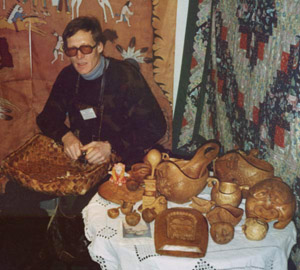 Master Ladonin woodcarving. For pictures of some of his works, see Carvings section of this web-site. |
|
As G.I. Gurdjieff explained to his pupils, any symbol that perpetuated itself in folk art has meaning so profound that only the initiated can fully understand it. This is absolutely true as far as traditional Russian woodcarving is concerned. Only two examples. Look at the cookie mold to the right. Where most people see only a flower of 6 petals, a careful observation reveals a sun of 6 rays, stars between them and Earth (the band of squares, crosses and triangles around the Sun). Moreover, it is representative of the Trinity (three rays crossing in one point). Futhermore, the rays are clearly vibrations emanating from the Center - vibrations that create sky (the space between the rays), stars on it, Earth and Water (the "petals" of the mold). Here are four elements reflected on several levels of being. Thus, this carving depicts no less than the whole Creation! | 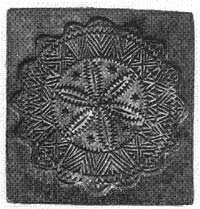 Cookie mold (19th century) from the collection of Smolensk museum. | |
| For comparison, the scheme to the right is taken from a book of one of the greatest modern physicists, Dr. G. Pat Flanagan, and represents his vision of the vibrational tri-united nature of the Universe. | 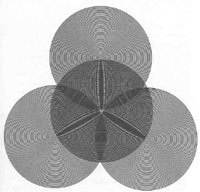 Scheme of Creation from the book Beyond Pyramid Power by Dr. G. Pat Flanagan. | |
|
Another example. Here is another cookie mold from Smolensk museum. Here comes the Sun! The same vibrations emanating from the center and the Earth bathed in them. But why is the center devided in 4 parts? As it turns out, the nucleus of an atom of helium ("helium" means "solar" - this element was first discovered on the Sun and comprises 27% of the Sun's mass) consists of 4 parts: two protons and two neutrons! Quite a remarkable knowledge of 20th-century nuclear physics on the part of a simple Russian peasant of the 19th century, who carved this mold! It is for this reason that I look with utmost respect and gratitude at the symbols and patterns preserved by my ancestors. They reveal more truths than any modern science or religion can "discover". | 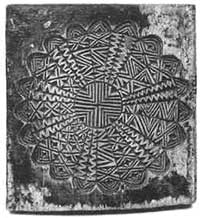 Cookie mold (19th century) from the collection of Smolensk museum. |
|
Kovsh-konjukh, or horse-ladle, is one of the most beautiful traditional Russian home utensils. It embodies a very deep symbology. The ladle represents the horse that carries the Sun (carved on its chest) through the ski. At night it travels, floating like a duck, over an ocean under earth, to come to the ski the next morning. The horse has three heads representing movement of the Sun over the Earth: morning, noon, and evening. Large ladles are called bratina from the Russian word brat, brother. At feasts they were passed around the table from one man to another, the horse head pointing in the direction of movement, making a circle clockwise (sun movement). When men remembered a friend who succumbed in a battle, the ladle traveled counter-clockwise around the table. The edges of the ladle have vertical traits representing rain. The tail of the horse has a flower on it representing life-giving qualities of the horse-sun. Many ladles have a writing - often humorous - teaching a morale. In this case it reads: Ne khvali pivo pazlivshi v suete mirskoi, a khvali raspivshi krugom s druziami sei kovsh tverskoi ("Praise not the ale that you poured in mundane vanity, but the one that you drank in a circle of friends from this ladle of Tver"). | 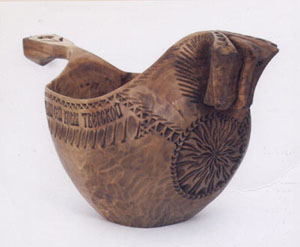 Traditional Tver horse-ladle, 10 inches wide, woodcarved by Master Ladonin. For more pictures of this remarkable ladle, see Home Utensils in Carvings section of this web-site. |
 |
    
|
